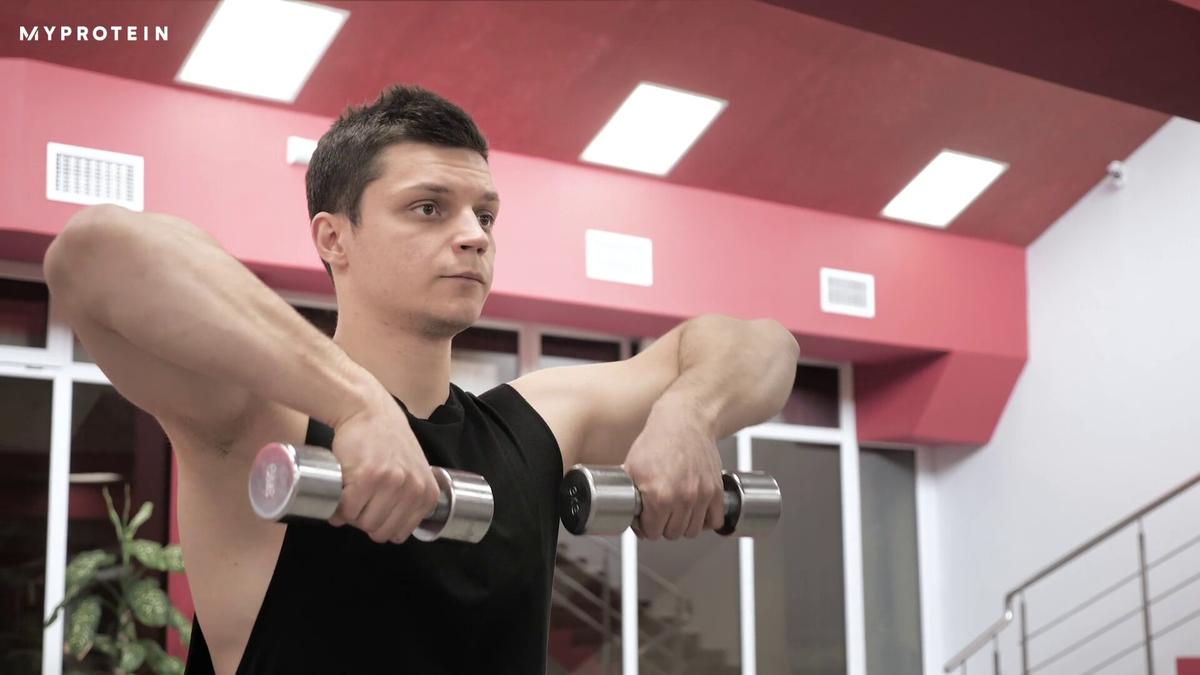How To Do A Dumbbell Upright Row | Benefits & Technique

If you want to shape your shoulders and bring out your traps, then the dumbbell upright row is an essential exercise.
Well-developed shoulder muscles can really make your upper body stand out and help you achieve that that v-taper aesthetic physique that many people aspire to.
What is a dumbbell upright row?
The dumbbell upright row is a compound exercise that targets your deltoids (shoulders) and traps (upper back) and biceps.
It’s a really simple exercise to perform. You hold a dumbbell in each hand and lift them vertically until they’re level with your collarbone, before lowering them back down.
Although it’s a simple move, it’s very easy to get wrong. Mastering the technique is important, ensuring you’re maximising the muscle-building potential on your traps.
How to perform a dumbbell upright row
https://youtu.be/TouTHqBQH74
1. Hold the dumbbells at arm's length down by your thighs with your palms facing towards you. Your grip should be just less than shoulder width.
2. Slowly lift the dumbbells, keeping them close to the body with your elbows driving the motion. Your elbows should be higher than your forearms through the lift.
3. Once the dumbbells are level with your collarbone (nearly touching your chin), pause for a second at the top of the movement.
4. Slowly lower the dumbbells back down to your thighs and repeat for the desired amount of reps.
The benefits of dumbbell upright rows and the muscles worked
The main muscles involved in the dumbbell upright row are the trapezius (traps), deltoids (delts), and the biceps. The traps and delts work together to raise your arms, while the biceps work to flex and bend the elbow.
Common mistakes and how to fix them
As with most free weight exercises, you’ll always see some mistakes in and around the gym. It’s important to get the technique right and avoid any unnecessary injuries. Here are some mistakes you’ll want to stay clear of.
Swinging the weights
You see this a lot when the weight is in front of you. Swinging the weight up, using your momentum, takes away the tension from the muscles — meaning the exercise will be less effective.
This not only hinders your muscle-building potential but it can also cause injury, like most exercises when you’re not using the correct form.
Swinging the weight and using momentum can be a sign that you’re trying to lift too heavy. Don’t be afraid to use a lighter weight.
Remember, always keep your back straight and avoid leaning forward to gain an advantage. You'll only be cheating yourself...
Going too heavy with little range of motion
This isn't an exercise for lifting heavy. Using heavy weights can potentially cause injury and take away the full range of motion.
Unlike seated a shoulder press, where you’ll be able to lift heavier weights, the form is more important with dumbbell upright rows. Don’t ego lift. Pick a weight that’s right for you and allows you to complete full reps.
Variations and alternate exercises to the dumbbell upright row
1. Lateral raises
Lateral raises or lat raises, as they're more commonly known, are a popular exercise that focuses on the deltoids and helps to build bigger shoulders. It's a very simple exercise but extremely effective. But, just because it's simple, doesn't mean it's easy. Lat raises can be hard even with light weights — so choose your weight wisely.
https://youtu.be/2kLrHfLmUAA
Stand with a dumbbell in each hand resting at your sides. Slowly lift the weights outwards until your arms are parallel with the floor. Lower the dumbbells back down and under control throughout. You'll find this exercise is harder the slower you are.
2. Seated dumbbell shoulder press
This powerful move is perfect if you're looking to build big, broad, shoulders. The seated dumbbell shoulder press helps to develop the front deltoids (delts), and because you're doing this from a seated position you'll be able to lift heavier weights. This is because you're torse and stabilising muscles are supported by the bench, so all the focus is directly on the shoulders.
https://youtu.be/UXy79ivGwXY
Sit on the bench holding two dumbbells at shoulder height, your palms facing forward and elbows pointing out to the side. Press the weights up above your head until your arms are fully extended. Return to the start position, keeping the dumbbells under control throughout the whole movement.
3. Dumbbell Arnold press
Named after Arnold Schwarzenegger, this is exercise is effective as it targets all three sections of the deltoids. The result? You'll build fuller, wider, more defined shoulders, without having to lift heavy. That's because the Arnold press keeps the muscles under tension for longer, stimulating muscle growth.
https://youtu.be/W3Gqnx7UICU
Hold a dumbbell in each hand, with your arm bents, so your palms are facing you. Instead of pushing the dumbbell up, spread your arms to each side, before pressing your arms up and twisting your hands, so your palms are facing forwards. It's important to make sure you're back is flat against the bench throughout the whole exercise so you're only targeting your arms and shoulders.
4. Dumbbell front raise
The dumbbell front raise is one of the best exercises for working on your front delts. It's an isolation movement for shoulder flexion and will help build strength and definition in the front and sides of your shoulder.
https://youtu.be/xvJnLIycpbk
Begin by holding both dumbbells, with your palms facing your body. Lift one dumbbell straight in front of you, until your hands are in line with your shoulders. Pause for a second, before slowly lower back to the starting position. Repeat with the opposite arm, alternating until you reach the desired amount of reps.
Take home message
Although your shoulders are the smaller of the muscle groups and in no way come close to the size of your back, having them well-developed really will improve your physique nicely. Dumbbell upright rows are a great exercise for shoulder and trap muscular development and the perfect addition to your upper body workouts.
Remember not to go too heavy, no one wants a nasty shoulder injury which hinders training not only on shoulders but also the chest. Keep the weight to a range that allows you to complete around 12-15 reps, with the last 2-3 being a struggle.
This really is an exercise for anyone. Remember to mix it up every so often, and not to get caught up in the same old exercises, so you can continue to challenge yourself and your body.

How To Do A Chin-Up | Benefits & Technique
All you need is a pull-up bar and your bodyweight…

Dan Speakman is our editor and level 3 qualified Personal Trainer. Having spent time in Australia, he has experience in planning and delivering exercise plans to beginners and advanced athletes — both in the UK and down under.
Dan has also run successful weight-loss camps across the UK, alongside regular training seminars, covering all areas of gym-based training. He also runs weekly fitness boot camps and spin classes.
When he’s not working, or in the gym, Dan enjoys travelling to sunnier destinations, eating out, and trying exciting new foods.










